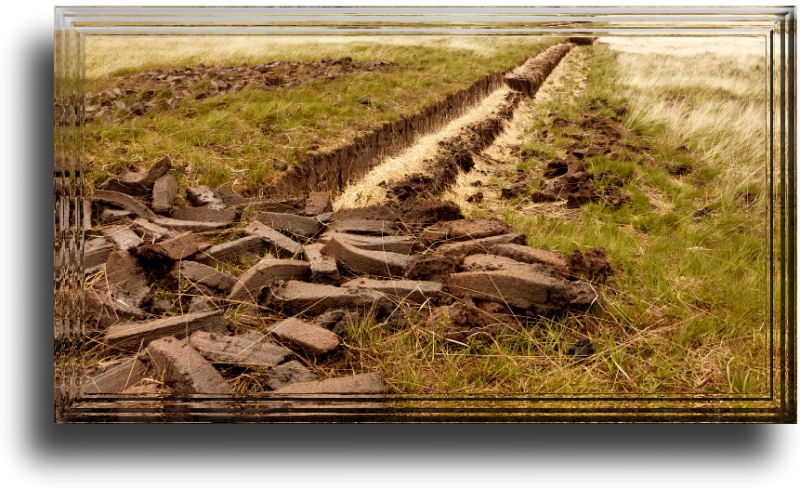
The 4th
element
If you have ever attended a tour of any of the Scottish whisky
distilleries you ought to have heard the tour guide say -
”There are three things needed to make good whisky - water,
yeast and malted barley”. Well, that IS true but to the
inhabitants of Islay there is a fourth ingredient, well known to
malt whisky lovers of the world... peat!
Large parts of Scotland (about 11% of which blanket bogs stands
for 10) are covered by a layer of peat, usually more than one meter
thick. This layer was formed during the last five thousand years.
The peat was formed in waterlogged lands by partial degradation of
organic matter and the composition of the peat depends on the micro
climate and the specific flora in the different areas. Britain
actually holds 13% of the worlds blanket bogs.
Peatlands are usually divided into bogs, fens, marshes and
swamps. Bogs are formed in areas of heavy rainfall (therefore
called ombrotrophic) and usually consists more of sphagnum moss and
less of woody vegetation than the other types of peatland which
usually are formed by waterlogging from the ground water
(minerotrophic). Fens (also known as valley or basin bogs) contain
more grass and herbal compounds. Marshes are treeless and
intermittently waterlogged areas and normally the peat growth is
very slow. Swamps are extremely minerotrophic and usually contain
large amounts of wood material.
Average peat contains approximately 90% water and 10% dry
matter, of which 92% is organic and 8% inorganic. Organic matter
mainly consists of residues of lignin and other carbohydrates, but
variations are vast depending on the local vegetation and the bog
type. Ombrotrophic peats are usually richer in phenols and other
aromatics, but due to the poorer vegetation they are low in
carbohydrates, lignin and nitrogen. The acidity level is also high.
The Islay peat has phenol levels of approximately 14.5% which is
significantly higher than the mainland peats (<12%).
Western Scotland and the islands are especially abundant with
blanket bogs and Islay is no exception. The growth rate of the
moors is approximately one millimeter/year. If a moor is two meters
thick it is therefore about 2,000 years old.

Peat and
whisky
Since ”the dawn of
time” peat has been used as a fuel in Scotland. Dried peat
burns fast and therefore delivers a vast amount of energy in a very
short time. Traces of old or new peat harvesting can be seen in
most peat bogs all over Scotland. The peat is dug in narrow strips
and subsequently piled in pyramids to dry. The water is rapidly
lost, following the law of gravity, and the soft strips are turned
into hard briquettes. A well planned peat ”harvesting”
will allow the peat bogs to remain unharmed as the regrowth of peat
will be at least as quick as its harvesting. So where does peat
enter the whisky business? As a fuel maybe? Well, in the old days
when there were neither oil nor electricity, peat was definitely
the cheapest and most widely available source of energy. It was
used to heat the pot stills but nowadays that is considered
history. Peat has been put aside and newer energy sources like
electricity and steam has entered the scene. So, why is peat still
important? Well, the answer is – phenols! Drying the damp
malted barley over a slowly burning peat fire adds a peaty, smoky
aroma to the finished product. This aroma is certainly an aquired
taste and has for decades been the trademark of Islay whisky. Well
known brands like Laphroaig, Lagavulin, Caol Ila, Ardbeg and
Bowmore are all more or less smoky. Of the phenols contained in
peat only a small part (about one third of the original level) is
transferred to the finished product and during the years of
maturation the level is constantly getting lower due to evaporation
and oxidization.
To log your visit you have to email me
the answers to these questions and wait for
confirmation:
1 – Examine the top layer of the peat (the living part).
The main constituent of that layer is...
A. Sphagnum moss, B. Salt grass or C. Heather
2 – At the coordinates you can see a well defined wall
where peat is being cut. What is the approximate length of this
wall in feet or meters?
3 – Using the growth rate stated above, approximately how
many years does the mentioned vertical cut represent? Please also
give the height of the wall, measured or estimated.
Should you take a picture of yourself or any other
”interesting things”, please post it as well. Always a
pleasure to see who you are!
Send your answers to the cache owner and wait for an OK before
you log your visit, please.
Good luck!
 The most exciting way to
learn about the Earth and its processes is to get into the outdoors
and experience it first-hand. Visiting an Earthcache is a great
outdoor activity the whole family can enjoy. An Earthcache is a
special place that people can visit to learn about a unique
geoscience feature or aspect of our Earth. Earthcaches include a
set of educational notes and the details about where to find the
location (latitude and longitude). Visitors to Earthcaches can see
how our planet has been shaped by geological processes, how we
manage the resources and how scientists gather evidence to learn
about the Earth. To find out more click HERE.
The most exciting way to
learn about the Earth and its processes is to get into the outdoors
and experience it first-hand. Visiting an Earthcache is a great
outdoor activity the whole family can enjoy. An Earthcache is a
special place that people can visit to learn about a unique
geoscience feature or aspect of our Earth. Earthcaches include a
set of educational notes and the details about where to find the
location (latitude and longitude). Visitors to Earthcaches can see
how our planet has been shaped by geological processes, how we
manage the resources and how scientists gather evidence to learn
about the Earth. To find out more click HERE.

Free counters